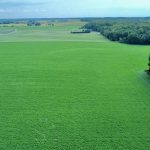Western Canadian farmers will soon see changes to the way wheat and barley checkoffs are collected.
What’s not yet clear is how those changes will be implemented or what the new levy system will look like.
Garth Patterson, executive director of the Western Grains Research Foundation, said his organization will be involved in discussions with the federal government over the next few months to determine how wheat and barley checkoffs will be collected once single desk grain marketing is eliminated.
It is expected that producer levies will continue to be voluntary, giving producers the opportunity to request a refund of any money withheld.
Read Also

Forecast leans toward cooling trend
July saw below average temperatures, August came in with near to slightly above average temperatures and September built on this warming trend with well above average temperatures for the month.
It is also likely that levy collection will take place at the point of sale.
“I think it will be something that everyone is comfortable with and familiar with,” Patterson said.
An important component in the proposed legislation to end the Canadian Wheat Board’s single desk is a provision allowing for the collection of a producer checkoff on all sales of wheat and barley, including feed grade crops.
As a single-desk grain buyer, the CWB has traditionally collected producer checkoffs on board grains, including wheat and malting barley, but not on feed barley.
Patterson stopped short of saying a new checkoff on feed barley would be introduced, but he acknowledged that the opportunity to introduce such a levy exists within the proposed legislation.
“We will likely see an increase in scope,” he said.
“I can’t get into details yet until we have those discussions (with Ottawa), but it appears the legislation allows for the collection of the checkoff on all sales of wheat and barley so … that means, to us, more than just wheat board sales.”
Voluntary producer checkoffs are a critical source of funding for research and development initiatives.
The wheat board has previously acted as the primary collection agent, deducting levies from farmers’ final payments on wheat and malting barley.
Those funds are forwarded to the WGRF, whose board manages check-o ff money and decides which research initiatives should receive producer support.
Some barley industry researchers say the lack of producer checkoffs for feed barley has resulted in chronic underfunding for feed barley research.
They say the vast majority of barley research and barley breeding initiatives are targeted at the malting barley industry rather than the feeding industry.
As a result, yield and agronomic improvements that could be bred into new barley varieties are sometimes overlooked if the cultivar does not have good brewing characteristics.
The CWB currently collects checkoffs for wheat in all four western provinces, while malting barley checkoffs are collected by the board in Manitoba, Saskatchewan and British Columbia.
In Alberta, the Alberta Barley Commission collects its own barley checkoffs on malting and feed barley varieties.
In 2010, the WGRF received $6.4 million through producer checkoffs, including $5.4 from CWB wheat sales and $1 million from CWB malting barley sales.
Levy rates are set at 30 cents per tonne for wheat and 50 cents a tonne for malting barley.
Patterson said the WGRF has remained neutral in the debate over whether Western Canada should retain a single desk marketing system or move to an open market structure.
However, he said the foundation was pleased that proposed legislation recognizes the importance of investment in research and development.
“We’re very pleased with what we’ve seen in the proposed legislation because it does allow for the continuation of a checkoff for wheat and barley research for a five–year period,” he said.
“At the end of that five years, we expect to be part of a new model, whether that be a national council or (some other organization)…. The intent is to look at some kind of new … model for the wheat and barley industry and we look forward to being a part of that.”
Brian Otto, a farmer from Warner, Alta., and president of the Western Barley Growers Association, said his organization would like to see a new research and development organization that has a national mandate and representation from all sectors of the barley industry.
In a recent submission to the federal working group on marketing freedom, the barley association floated the idea of establishing a national barley council that is supported by provincial commissions and producer checkoffs across the country.
“The model that we want in place is a model that will work for the whole industry,” Otto said.
“Ideally, the organization … put in place would involve the whole value chain in the barley industry to decide on market development and research initiatives in breeding and agronomics. We would be looking for an organization that has input from every sector of the barley industry, from producers right through to end users and processors.”
Proposed amendments to CWB legislation also contain provisions for continued funding to the Canadian International for Grains Institute and the Canadian Malting Barley Technical Centre. They are market development agencies that promote the sale and use of Canadian grain at home and abroad.















